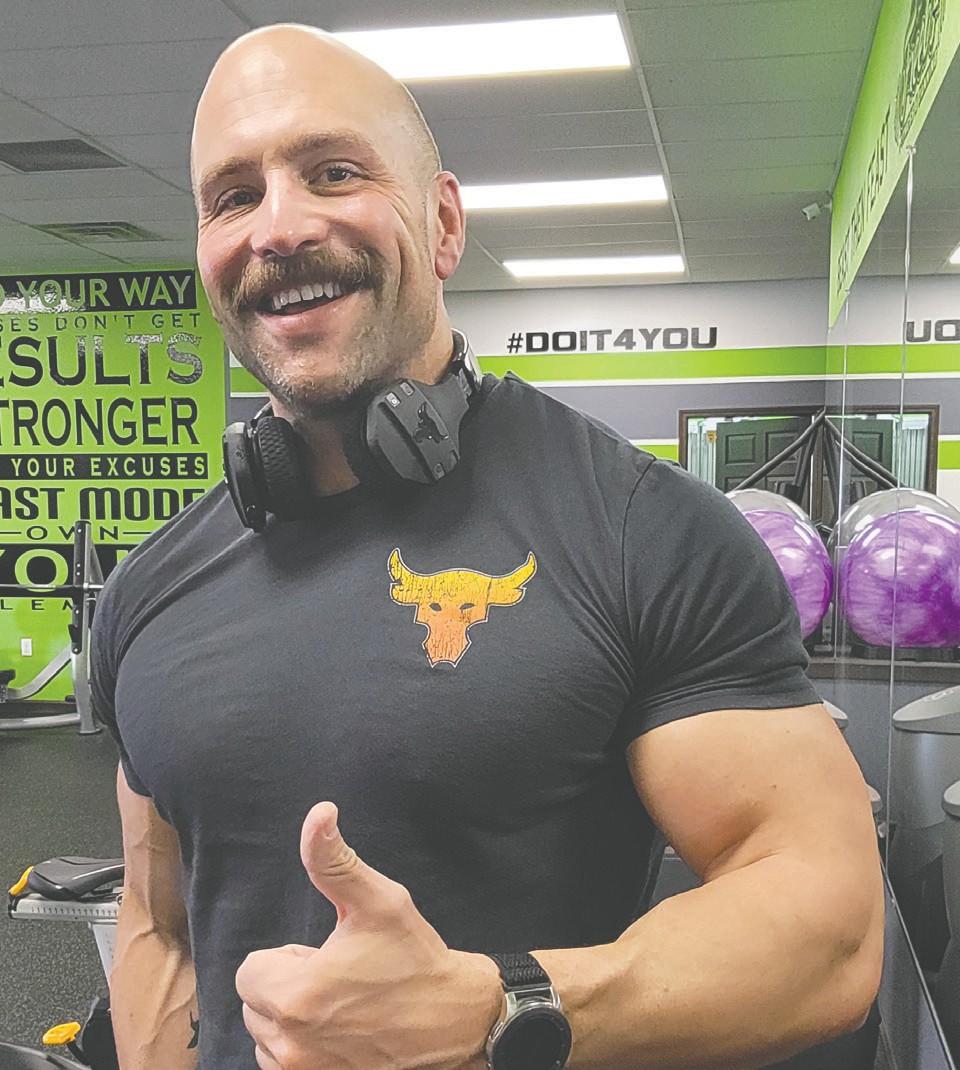Greg Mahler in his home away from home – the gym. Submitted photos.
Chances are, you’ve probably seen or heard something regarding keto on the news, in a magazine or even on a store shelf. There’s so much buzz out there these days, but how much of it is worthwhile and what the heck is keto anyways?
My name is Greg Mahler. I’m from Hibbing, and I’ve thrived on a ketogenic lifestyle for the last 10 years. In fact, I was dabbling with the “low carb” dietary approach long before it was anywhere as mainstream as it is now. I’ve learned quite a bit along the way, and I currently coach clients across the globe.
There’s a lot of misinformation and conflicting guidance out there nowadays, and it can be super confusing for those who are looking to improve their health. When I was self-experimenting with my own nutrition, there was no keto bread, keto ice cream, keto bars or keto cereal around. That has all come to light recently, and most of it is highly processed garbage. Keto tends to get a bad reputation because it’s commonly misunderstood or improperly followed.

Greg Mahler is a ketogenic bodybuilder who prides himself in competing using all natural methods to reach this impressive physique.
If you’re not familiar with the basics of keto, let’s break it down. Ketosis is a natural metabolic process within our bodies that typically comes into play when we restrict our intake of carbohydrates. This is not to be confused with ketoacidosis, which is a whole different topic.
Without carbohydrates, our body searches elsewhere for a usable source of energy. Our liver steps up to bat and begins producing ketones from fatty acids. Those ketones are then used throughout our body as a new source of energy. There’s a little more to it, but that’s the surface-level overview.
Let’s be honest, our standard American diet is loaded with refined carbohydrates, way too much sugar, poor-quality ingredients and inflammatory oils. Obesity, type 2 diabetes, pre-diabetes, chronic diseases and various ailments are driving people into early sickness and death. The food industry is maximizing profits at the expense of our health.
Breaking away from the standard American diet can drastically improve our well-being, I’ve helped countless people do it. A properly formulated ketogenic diet has been shown to offer countless health benefits, including:
• improved blood sugar/insulin levels & stability
• reduced aches and pains
• less inflammation
• improvement in body composition
• weight loss
• improved brain function
• better sleep quality
• increased energy
• reversed type 2 diabetes
• reduced insulin resistance
• improved blood pressure control
• appetite regulation and less cravings
• an overall renewed quality of life
WHAT DOES THE KETO DIET INCLUDE?
The ketogenic way of life goes against the grain of conventional dietary guidelines, which is a whole different rabbit hole topic for another day– don’t even get me started.
For example, we focus on quality fat and protein sources rather than numerous servings of grains or starchy carbs per day. Our body uses that dietary fat as fuel in the absence of carbs.
Here’s a basic sample grocery/food list for succeeding on a ketogenic journey of your own:
MEATS AND PROTEIN: ground beef, steak, bacon, pork, sausage, chicken, turkey, pepperoni, salami, fish, ham, lamb, wild game and jerky/meat sticks.
DAIRY AND FATS: eggs, heavy cream, sour cream, cream cheese, cheese, yogurt, butter, tallow, ghee, avocado oil, coconut oil, MCT oil and extra virgin olive oil.
FRUIT AND VEGGIES: avocados, berries, broccoli, cauliflower, spinach, asparagus, Brussels sprouts, cucumbers, mushrooms, onions, peppers, celery and lettuce.
OTHER: walnuts, pecans, almonds, macadamia nuts, nut butters, pork rinds, cheese crisps, tea, coffee, zero calorie drinks and electrolytes.
THINGS TO AVOID: grains, starchy veggies, bread, baked goods, candy, sweets, cookies, crackers, chips, noodles, rice, vegetable oils, seed oils and added sugar.
So, what about the keto bread or keto cookies on store shelves?
Well, those are the food industry’s profit-seeking responses to people finding success with an actual ketogenic diet. Those “keto-friendly” versions of non-keto foods are usually highly processed and contain poor-quality ingredients.
The food industry leverages the idea of “low net carbs” to make them “fit” into ketogenic ideology and appeal to those on a ketogenic diet. Honestly, it’s a shame. It’s very misleading.
When in doubt, turn the product around and read the list of ingredients. If it still contains wheat, gluten, starches, poor-quality oils (canola oil, soybean oil, safflower oil, etc.) or weird ingredients, put it back on the shelf. Stick to whole foods with minimal ingredients and low total carbs as much as possible.
There are thousands of keto recipes floating around the internet these days, and people have become quite creative. As long as they’re low in total carbs, options are limitless!
My favorite meals are actually pretty simple: • Beef bowl: ground beef, butter, scrambled eggs, cheese and hot sauce. • Chaffles: waffles made from eggs and cheese, and toasted in a waffle iron. • Pork rind nachos: rather than making nachos with high-carb chips, swap them for higher protein pork rinds. • Bun-less bacon cheeseburgers: skip the bun completely or swap it for a lettuce wrap.
• Tuna salad/egg salad wraps: swap the tortilla wrap for an egg white wrap and load it up with cheese, tuna salad or egg salad, lettuce, onions, peppers, etc.
• Baked salmon and veggies: easy and so delicious.
• Ribeye with garlic butter and Caesar salad: sounds too good to be true, right? My favorite!
When people are starting out on a ketogenic journey, I like to offer some basic guidelines to maximize success and streamline the transitional phase. Replace excessive carbohydrate consumption with healthy fats and protein. Eat when hungry, stop when satiated, and minimize snacking.
TOP FIVE TIPS FOR JUMPING INTO KETO
• Commit to it long enough to let your body transition into a state of ketosis. This means cutting the carbs down low (usually under 30 grams per day) and keeping them low daily. No cheat meals, and no “carb days.” Give your body a chance to make the metabolic switchover, or you’ll forfeit actual progress. This transition can take several days or weeks.
• Remove alcohol from your diet. Alcohol contains nutrient-void calories and actually inhibits your body’s ability to produce and metabolize ketones.
• Be sure to stay hydrated and increase your consumption of electrolytes. When we remove carbohydrates from our daily lives, we initially flush water retention, and electrolytes become unbalanced or inadequate.
Supplemental sources of sodium, potassium, magnesium and calcium are very helpful.
• You may experience transitional symptoms as your body makes internal changes. These are commonly referred to as “keto flu” symptoms because they sometimes mimic the symptoms of the common flu. Staying hydrated, increasing electrolytes, consuming plenty of healthy fat and exercising can help shorten the length of them.
• Avoid the “keto” versions of traditionally high-carb foods such as breads, grains, noodles, cookies, crackers, sweets, etc. They will prevent you from really thriving as much as possible.
Hopefully this helps debunk some of the misinformation that surrounds the ketogenic world and sheds some light on its many benefits. This is a much deeper topic than I’m able to include here, so feel free to connect with me on social media. If you’d be interested in personalized oneon one ketogenic coaching, I offer that service to clients worldwide.
Disclaimer: This article is not to be interpreted as medical or nutritional advice. A ketogenic diet may not work best for everyone, some people encounter side effects. Always consult your healthcare provider(s) before embarking on a journey of your own.
Greg Mahler resides in Hibbing, where he works as an International Sports Sciences Association certified personal trainer at Freebs Fitness & Tanning 24/7. He also works online with ketogenic nutrition clients across the globe. You can find Greg on Facebook, Instagram @ KETOGREG80 or his ketogenic coaching page, deeperstateketo.com/greg-mahler.
